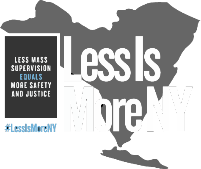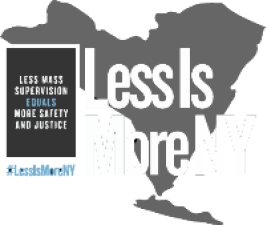**MEDIA ADVISORY**
September 23, 2021
Contact: Yonah Zeitz – 347-201-2768 yonah@katalcenter.org,
Emily NaPier Singletary – 315-243-5135 emily@weareunchained.org
Follow online: #LessIsMoreNY | www.lessismoreny.org
Statement from Leadership of the #LessIsMoreNY Coalition on Today’s Misleading NY Post Story About the Less is More Act
Syracuse, NY: Today, the New York Post published a misleading article about the Less is More Act, regarding a person on parole who was detained in Monroe County. The leadership of the #LessIsMoreNY Coalition issued this statement in response, attributable to Emily NaPier Singletary, Co-Executive Director of Unchained, a Syracuse-based community organization:
“As usual, the NY Post is being misleading in an effort to sell papers and generate clicks online. The problem highlighted in this story is not with the Less is More Act; the problem being exposed here is with the Monroe County District Attorney and police departments. This individual did not get released as a result of the Less is More Act and then go on to commit a new crime. He was already a suspect in a murder case, and the police and District Attorney had intentionally not filed charges against him. This is a common practice not just in Monroe County but across the state. Law enforcement agencies rely on technical parole violations to detain people either because they do not have the evidence to formally charge them or because they are trying to circumvent their due process rights in the criminal court system. In this specific Monroe County case, the police and District Attorney clearly had the evidence to charge the individual as they did so just hours after he was released from jail on the technical parole violations. Had they filed charges in a timely manner rather than intentionally stalling, he would not have been released. He was eligible for release only because law enforcement did not do their jobs. Thus any risk to public safety presented by his release was a result of negligence and malfeasance from law enforcement, not from the Less is More Act.
Under the Less is More Act, when people on parole are charged with new crimes, they are not eligible for automatic release and will receive a recognizance hearing where a judge will determine whether to detain, release, or set bail. Only those who are detained on non-criminal, technical violations of parole (like missing an appointment or being late for curfew), are eligible for automatic release. If the Monroe County DA had charged this person, he would not have been released.”
About the Less Is More Act: Parole supervision, and the resulting incarceration of people for technical parole violations, disproportionately impacts Black people, families and communities. Parole in New York is wrought with racial disparity: In New York City, Black people and Latinx people are 12x and 4x more likely to be incarcerated for a technical parole violation. In New York State, Black people are incarcerated for technical violations of parole at 5x the rate of whites, and Latinx people are 30 percent more likely than whites to be reincarcerated for technical parole violations.
The Less is More Act impacts the more than 35,000 people on parole supervision in New York, improving public safety while strengthening the reentry process. The law restricts the use of incarceration for most technical violations, bolsters due process, provides speedy hearings, and provides an earned time credit for most people on parole.
About the #LessIsMoreNY Campaign: #LessIsMoreNY is a statewide coalition of more than 300 community, faith, and advocacy groups; 8 District Attorneys from the counties of Albany, Bronx, Brooklyn, Manhattan, Nassau, Tompkins, Ulster, & Westchester; law enforcement leaders from across New York including the Albany, Erie, and Tompkins County Sheriffs, and more. The Coalition came together to develop and pass the Less Is More Act. Restricting the use of incarceration for noncriminal technical violations of parole will support people in reentering their community after incarceration; responsibly reduce jail and prison populations; promote safety and justice for families and communities; and save taxpayers money. A full list of supporters and more information on the Less Is More Act can be found at https://www.lessismoreny.org/supporting_letter
###

